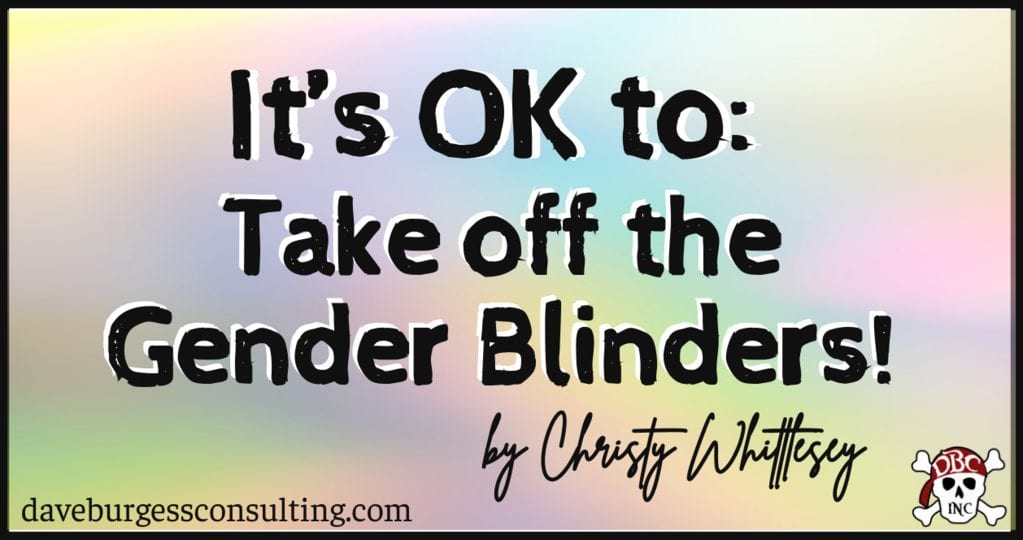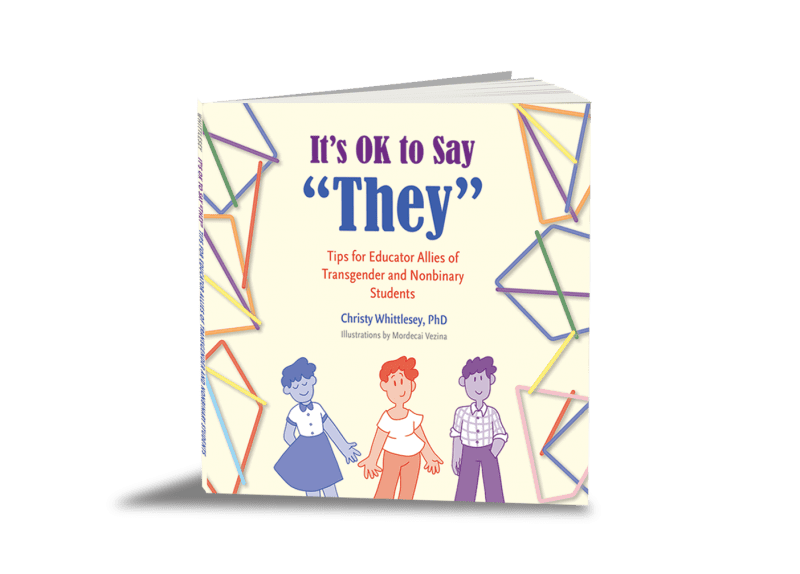Have you read It's OK to Say "They "by Christy Whittlesey? If not, you're really missing out! This book is full of information and resources to support educator allies of transgender and nonbinary students. It's a wonderful resource to answer the question: How can educators ensure all students—regardless of gender—feel safe, seen, and supported in their classrooms?
It's your lucky day, because we get to hear from Christy in today's DBC, Inc. guest blog! Open your mind and prepare to be inspired..
Guest Post by Christy Whittlesey
Gender is a big part of life, and there are a LOT of expectations involved once people decide what yours is – this typically coincides with whatever physical characteristics you have when you’re born and the sex you are assigned at birth. As soon as a baby arrives (or, more frequently today, when a gender reveal cake is cut open to reveal pink or blue), we tell ourselves a story about what the child will do, act like, wear, and grow up to do based on our society’s concepts of what a “girl” or a “boy” should be. For some people, how they feel inside about their gender aligns with the sex they are assigned at birth (the term for this is cisgender). For others, it doesn’t (the umbrella term for this is transgender). Often, a person’s journey to understand where their gender falls within the gender spectrum is complex, and evolves over their time. But regardless of whether a person is cisgender, trans, non-binary, etc., gender is an integral element of personal identity.
For example, I’m a cis lady. I was assigned female at birth, and I’m pretty comfortable with that. Although I don’t always adopt traditionally female gender expression like wearing heels or wearing makeup, I have never questioned my gender, worried about which bathroom to use in a public place, or been bullied because I am noticeably gender non-conforming. Whether I like it or not, my gender is constantly assumed and/or reinforced by others throughout the day: when a waiter calls me “Miss”, when a man holds the door open and says “Ladies first”, or, more recently, when I open Christmas gifts and see things like ponchos (I can never have too many ponchos), dangly earrings, or perfume.
Reminders about gender are all around us!
So why, then, do some educators decide the best thing to do to create a healthy classroom is to ignore gender altogether?
The Gender-Blindness Phenomenon
As part of my dissertation research, I presented my findings to an educator response focus group to see how they reacted to the stories I shared from the real-life experiences of transgender and non-binary students. To be clear: ALL of these educators volunteered their time to participate in the response group, as well as completing a survey. In other words, they were invested in the topic, and were committed to supporting trans students in their schools. But it was also clear through the response group’s discussion that most felt some anxiety about the “right” approaches to supporting trans students.
One participant in particular, Sally, a 49-year old high school English teacher, expressed a reluctance to engage in dialogue with students about issues of gender, or even to acknowledge different gender identities, in what she describes as an effort to be fair to all students:
In the end [someone’s gender] doesn’t matter. What’s important is the work they’re doing, not how they identify. Which is sort of, the approach that I’ve had with my students. I mean, occasionally I’ll get an email from guidance that says ‘You have this student in your class, we just want you to know that they prefer to be called by this name,’ and I look at the name and think, ‘That looks like a female name,’ and I kind of approach it as well – does it matter? I’m wrestling with the fact that if I treat you as a human being in my classroom and treat you fairly and don’t even distinguish between a female, a male, a …binary? I’ll be honest. To me the importance of the pronoun, it’s hard for me – dealing with that.
Sally truly believes that she is supporting equality in her classes by fostering relationships with students founded purely on the quality of their work, and she uses this as an excuse to avoid acknowledging non-cisgender identities in her classes. She also avoids using the terms “transgender” and “non-binary” in our discussion, instead emphasizing that she treats her students as “human beings.”
Sally’s personal discomfort with the topic parallels a common theme in research literature on teacher attitudes regarding transgender and non-binary students; the phenomenon of teachers who may be sympathetic to the needs of transgender students but are uncomfortable discussing gender and therefore avoid the topic altogether, has been widely documented. These teachers may believe they are creating equitable classrooms through this practice, but in reality, by ignoring this integral component of student identity, these educators are simply reinforcing the existing rigid gender binary system that exists in schools. In the worst cases, this may lead to a lack of intervention by teachers when derogatory remarks are made about gender expression; in a GLSEN (Gay, Lesbian, and Straight Education Network) National School Climate Survey, only 10% of students reported that their teachers stepped in to address the bullying taking place in their classroom.
In any case, teacher avoidance of gender diversity is not lost on students. Here are just a couple of statements from students in my study discussing how some educators clearly were uncomfortable acknowledging their gender:
“I think there was so little knowledge and it was such a taboo thing to talk about that nobody wanted to say the wrong thing, and so they just decided that saying nothing and just pretending it wasn’t there was best...I don’t think they wanted to hurt me, I just think they didn’t want to put their neck on the line, like it wasn’t worth the risk for them to help one kid.”
“One teacher in particular, you know he was kind of old fashioned and things like that, but I had a pretty low singing voice to begin with, and sometimes I would struggle with the alto singing parts, and I asked, ‘Can I please sing tenor on some of these songs?’ And he just did not like that at all, he was like, ‘No, you should just stay in your own section,’ and from then on he just like, treated me terribly. It was like, a switch went off…he was like, VERY odd about me wanting to be different.”
Each of these students was harmed in some way by teacher avoidance of their gender. Considering that gender is such an integral component in each of our lives, the teachers’ unwillingness to acknowledge this key element of a student’s identity is a rejection of the very basis of who these students are.
Parallels to Racial Discourse
The uncertainty, frustration, and discomfort apparent in Sally’s statements about gender identity in her classroom parallel some white teachers’ discomfort with racial discourse in predominantly white classrooms. When educators do not engage in discussions on race, they are avoiding problems of privilege and discrimination. This colorblind framework ignores characteristics of specific groups in order to treat people “equally as individuals.”
While some white people believe that adopting a colorblind perspective is helpful to people of color by asserting that race does not matter, this approach does not actually protect minority students, who may experience discomfort and isolation within this framework. In fact, colorblindness only serves to preserve existing power structures, as white privilege is left intact.
Just as the colorblind approach reproduces inherent power structures based on race, “genderblind” education does not create a fair system within classrooms, instead favoring the dominant group (people who are cisgender), and may prevent educators from implementing strategies that may help to resolve issues of gender inequity; for example, this can lead to a lack of intervention by educators in situations where they might have opportunities to combat negative comments about gender identity .
How to Take off the Gender-Blinders
Educators have great power to affirm or minimize the existence of youth in their classrooms! With this power comes a responsibility to acknowledge students as they are.
What types of things can you do to take off the gender-blinders to engage with students’ genders in appropriate ways?
Practice, practice, practice!
If a student changes their name or pronoun, it is our responsibility to honor the change. Breaking habits can be frustrating, so it’s important to practice on your own. Picture the student’s face while saying their name/pronoun out loud, or talk about them in the car using the correct name and pronoun.
Read and practice with the Human Rights Campaign (HRC) resource “Be Prepared for Questions and Put-Downs about Gender” so that you can feel more comfortable responding when issues arise: http://www.welcomingschools.org/pages/be-prepared-for-questions-and-put-downs-about-gender/
Be open to criticism.
It is inevitable that we will make mistakes as we strive to support gender-expansive students. I have made these mistakes too – and yes, it feels horrible. The best way to handle a tough situation (for example, if you accidentally use a “she” rather than “they” as requested) is to correct yourself and move on, rather than explaining to the student how guilty you feel, which only puts the onus on the student to comfort you.
Sometimes students correct our use of terminology; this may happen in private or in public. Recently, I was facilitating a workshop with graduate students who were engaged in student teaching, and one future educator expressed frustration that a student corrected his use of their pronoun in the middle of class. He was clearly upset that he had been “called out” in public. It may be challenging to avoid getting defensive in these types of situations, but being open to criticism and modeling this behavior for the class is imperative to not only affirming students’ gender, but also in building stronger relationships with students.
Open the door to engaging in discussions.
Use inclusive language in class and on materials sent home; you may also want to consider adding your pronouns to your email signature to send a message to students and families that you understand that gender diversity exists.
Post visual signposts such as the free posters available through GLSEN that show that your classroom is a welcome place for all (https://www.glsen.org/activity/glsen-safe-space-kit-be-ally-lgbtq-youth)
Advocate!
Speak up when you notice that things are unnecessarily gendered. Is a teacher next door lining students up by gender? Are there single-stall bathrooms in your school that are assigned to a gender? In these cases, it is appropriate to ask: Why? And can these practices be changed to create a more gender-friendly school setting?
Educate yourself!
There are so many fantastic (and free!) resources available online, including the ones I have listed at the end of this blog.
Visit Dr. Lee Airton’s website, theyismypronoun.com, for valuable information and Q&A.
Suggested Podcasts: Gender Reveal, Queersplaining, Gender Stories
In conclusion: there is great potential for ALL of us to learn and adjust our practices to create more gender-friendly schools. We are already adept at differentiating for a wide range of learning styles and needs, and acknowledging gender diversity is another way that we can create inclusive, equitable schools where all can learn. Let’s all take off our gender-blinders and do this!
Further Resources
- National Center for Transgender Equality – School Action Center (model school policies, information on laws and protections, and more): Click HERE.
- Gender and Children: A Place to Begin: Click HERE.
- Developing a Gender Inclusive School : Click HERE.
- Gender Support Checklist for Transgender and Non-Binary Students : Click HERE.
- Lesson Plans to Help Students Understand Gender and to Support Transgender and Non-Binary Children : Click HERE.
- Be Prepared for Questions and Put-Downs about Gender Sample questions – sample responses. : Click HERE.
- Diverse Children’s Books to Understand Gender and Support Transgender and Non-Binary Youth : Click HERE.
Thank You, Christy!
If you like what you've read, please follow Christy on Twitter at @ChristyWhittles and visit her Facebook page by clicking HERE.
Also, don't forget to check out her new release It's OK to Say "They "by Christy Whittlesey.
It’s OK to Say They
How can educators ensure all students—regardless of gender—feel safe, seen, and supported in their classrooms?
More info →References:
Castagno, A. E. (2008). “I don’t want to hear that!”: Legitimating whiteness through silence in schools. Anthropology & Education Quarterly, 39, pp. 314-333.
Cumming-Potvin, W. & Martino, W. (2018). Countering heteronormativity and cisnormativity in Australian schools: Examining English teachers’ reflections on gender and sexual diversity in the classroom. Teaching and Teacher Education, 74, pp. 35-48.
Ellwanger, A. (2017). No exit: White speech and silence in classroom conversations on race. Pedagogy, 17(1), pp 35-58.
Flores, G. (2012). Toward a more inclusive multicultural education: Methods for including LGBT themes in K-12 classrooms. American Journal of Sexuality Education, 7, pp.187–197.
Houston, B. (1985). Gender freedom and the subtleties of sexist education. Educational Theory, 35, 359-370. Reprinted as “Should public education be gender free?” in L. Stone (Ed.), The education feminism reader (pp. 122-134), 1994. New York: Routledge.
Kearns, L. M.-K., J. & Tompkins, J. (2017). Transphobia and cisgender privilege: Pre-service teachers recognizing and challenging gender rigidity in schools. Canadian Journal of Education, 40(1), pp. 1-28.
Kosciw, J. G., Greytak, E. A., Palmer, N. A., & Boesen, M. J. (2014). The 2013 National School Climate Survey: The experiences of lesbian, gay, bisexual and transgender youth in our nation's schools. New York, NY: GLSEN.
Kosciw, J., Palmer, N., Kull, R., & Greytak, E. (2013). The effect of negative school climate on academic outcomes for LGBT youth and the role of in-school supports. Journal of School Violence, 12, pp. 45-63.
Kraehe, A. & Brown, K. (2011). Awakening teachers’ capacities for social justice with/in arts-based inquiries. Equity & Excellence in Education, 44(4), pp. 488-511.
Leonardo, Z. & Porter, R. (2010) Pedagogy of fear: toward a Fanonian theory of ‘safety’ in race dialogue, Race Ethnicity and Education, 13(2), pp.139-157.
Puchner, L., & Klein, N. (2011). The right time and place? Middle school language arts teachers talk about not talking about sexual orientation. Equity and Excellence in Education, 44(2), pp. 233-248.
Tarca, K. (2005). Colorblind in control: The risks of resisting difference amid demographic change. Educational Studies, 38(2), pp. 99-120.
Thein, A. (2013). Language arts teachers' resistance to teaching LGBT literature and issues. Language Arts, 90(3), pp. 169-180.
Whittlesey, Christina. “Translations: Exploring and Sharig Experiences of Transgender and Non-Binary Students.” Unpublished doctoral dissertation, 2019. https://search.proquest.com/openview/2723f3460 44d544ae070bf4c0142bc75/1?pq-origsite=gscholar &cbl=18750&diss=y.





